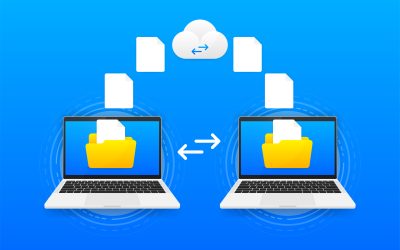Data is a crucial asset for businesses in this digital world. Organizations across all industries are diligently accumulating, storing, and analyzing vast volumes of information to identify decisive patterns, get valuable insights, forecast business outcomes, monitor consumer behaviors, and enhance customer engagement. One of the sectors where data analytics is making a huge impact is banking. The banking industry and its customers generate a huge amount of data every day. Data analytics has revolutionized the how information is processed, enabling financial institutions to recognize trends and patterns with remarkable precision. These valuable insights can then be leveraged to make informed and scalable business decisions. Banks are increasingly leveraging business process outsourcing solutions such as data mining and data cleansing to support their data analytics initiatives.
Role of Data Analytics in the Financial Sector
According to Allied Market Research, the value of global data analytics in the banking market stood at $4.93 billion in 2021 and is predicted to reach $28.11 billion by 2031, growing at a CAGR of 19.4% from 2022 to 2031. Over time, banking and financial institutions have transitioned from a product-centric approach to a customer-centric one. This shift in focus aims to prioritize and cater to the unique needs and preferences of customers, enhancing their overall banking experience. Data analytics helps banks understand their customers and their buying patterns and behaviors, which is driving the growth of the market.
The Digital-First Banking Tracker, a collaborative effort between PYMNTS and NCR, reported that a significant majority of American consumers, specifically 78%, now express a preference for conducting their banking activities digitally. Comprehensive analysis of the vast troves of financial data at hand can provide many benefits:
- Banks can make informed decisions via insights gained from the analysis of structured and unstructured data.
- It can drive innovative product development. New digital products and services, such as mobile banking apps, digital wallet and online investment platforms help banks better serve customers and stay competitive.
- By using analytics to learn more about customer preferences, multichannel touchpoints, and buyer behavior factors, banks can provide better customer service.
- Data-driven decisions lead to improved efficiency, reduced waste, and better resource allocation, resulting in both time and cost savings.
- Data-driven performance analysis provides a clear and comprehensive view of key performance indicators (KPIs) crucial for assessing business success and financial health.
- Advanced analytics can swiftly identify fraudulent activities and transactions, preventing financial losses and the need for extensive manual investigations.
Data Analytics for Banking Demand and Supply Management
Banks and financial institutions are applying data analytics to manage both the supply and demand side of their operations.
Using Data Analytics to Manage the Supply Side
On the supply side, data analytics plays a crucial role in optimizing internal processes and resources.
- Sales Performance Analysis – Analytics empowers banks with data-driven insights and enables them to optimize their sales processes, enhance customer engagement, and make informed decisions that drive revenue growth and long-term success. Various types of financial transactions take place on a daily basis such as opening of new accounts, applying for loans, etc. Analytics helps banks identify and track key sales metrics and performance indicators, such as the number of new accounts opened, loan applications processed, cross-selling success, and customer acquisition rates. These metrics enable banks to assess the performance of individual sales representatives, teams, and the overall sales function. Performance analysis measures performance over time – whether it’s sales performance or cash flow analysis and it enables to track and measure results over multiple periods to determine what is happening at each stage of the banking business.
- Branch and Online Channel Sales Analysis – For banks and financial institutions, their branches and online channels are links in their supply chain that they need to manage. Banks need to consider the amount of cash flow, what is coming in through the channel, and what is going out through the channel. It is important to know how the performance of the branches and online channels impact banking business. Branch sales are more profitable per capita, but they account for a smaller percentage of the total sales. Online transactions make up a larger percentage of total revenue per customer, but they do not generate as much profit per sale. The key is to focus on the bigger picture. This is where the significance of data analytics comes in.
- AI-powered Chatbots and Virtual Assistants – AI-driven chatbots and virtual assistants can help reduce the amount of time customers and banking employees spend on their day-to-day financial tasks. Chatbots and virtual assistants assist in customer service and knowledge management, replace manual processes (such as emailing or calling rooms) and increase customer engagement through personalized interactions. Customers now prefer efficient self-service options to in-person contacts to process their requests. AI-powered virtual assistants add value in answering all the queries about products, services, and eligibility criteria in financial services. The technology is also used to obtain knowledge about clients’ financial habits and deliver more personalized solutions; provide more meaningful advice on investments; offer advice based on what clients have already invested in; and improve customer relationships through effective marketing campaigns.
Using Analytics to Manage the Demand Side
- Personalized Marketing – Managing the demand side of operations in banking and financial institutions can be challenging. Focusing on the most profitable customers allows banks to access new opportunities and secure profits. To achieve this, analyzing customer data to understand their needs and preferences is crucial for effective personalization. Utilizing various data sources, banks target specific customers with tailored marketing messages and offers. Strategic placement and timing of marketing efforts play a vital role in building trust and encouraging customer response.
- Lifetime Value Prediction – Customer lifetime value (CLV) prediction is a vital tool for understanding customers’ needs and wants in the banking industry. CLV represents the expected lifetime spending of a customer with a bank. To optimize their business models, banks must consider both customer value measures – brand value and customer lifetime value. While traditional analytics focus on brand value and its impact on revenue, CLV provides insights on future revenue sources and where marketing efforts should be directed. AI-powered advanced models are effective in identifying customer behavioral patterns and significant factors that impact their decisions, providing valuable insights beyond human capability.
- Product Recommendation Engines – In the banking sector, product recommendation engines are advancing to attract new customers and enhance the offerings to existing ones. Comparison sites have proliferated, prompting banks to use analytics for demand-side management. Predictive models based on customer characteristics enable personalized product and service offerings. Real-time machine learning models facilitate financial analysts in offering personalized solutions seamlessly without disrupting the customer experience.
Data analytics holds immense potential for facilitating the smooth operations of banking and financial institutions. Key functional areas like risk monitoring, compliance, fraud detection, NPA monitoring, and value at risk calculations can benefit from analytics, aiding in timely decision-making and optimal performance. Additionally, analytics can help banks differentiate themselves and maintain competitiveness. Partnering with a business processing outsourcing company can help banks implement data analytics successfully. Experienced companies providing data mining and cleansing services and related solutions can empower banks to leverage analytics to make informed decisions, reduce risks, and enhance their overall efficiency, leading to improved customer satisfaction and long-term success.
Unlock the full potential of your data and make data-driven decisions for success with our BPO services!
Contact us today!




